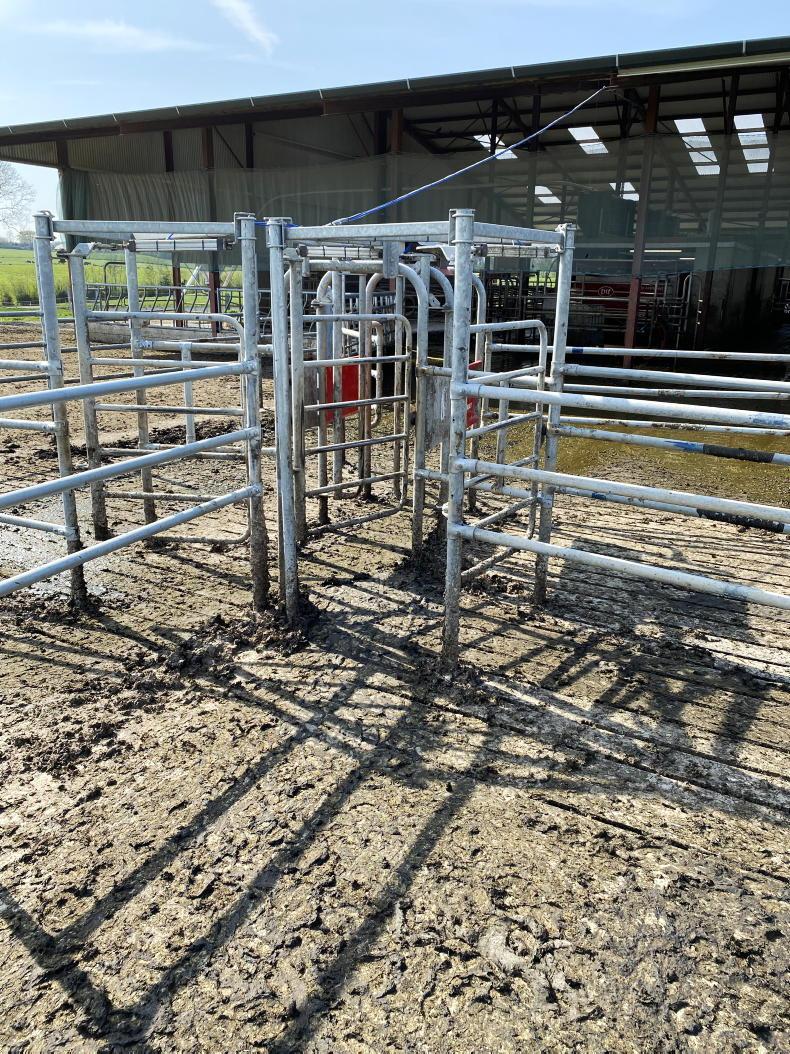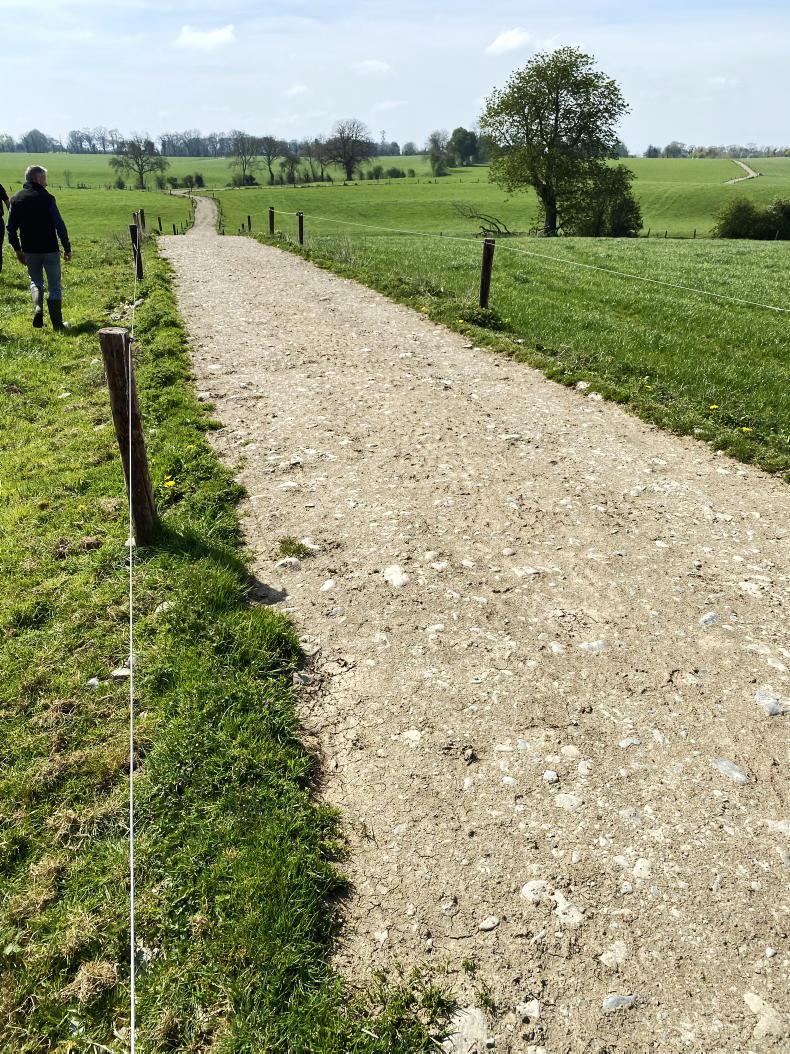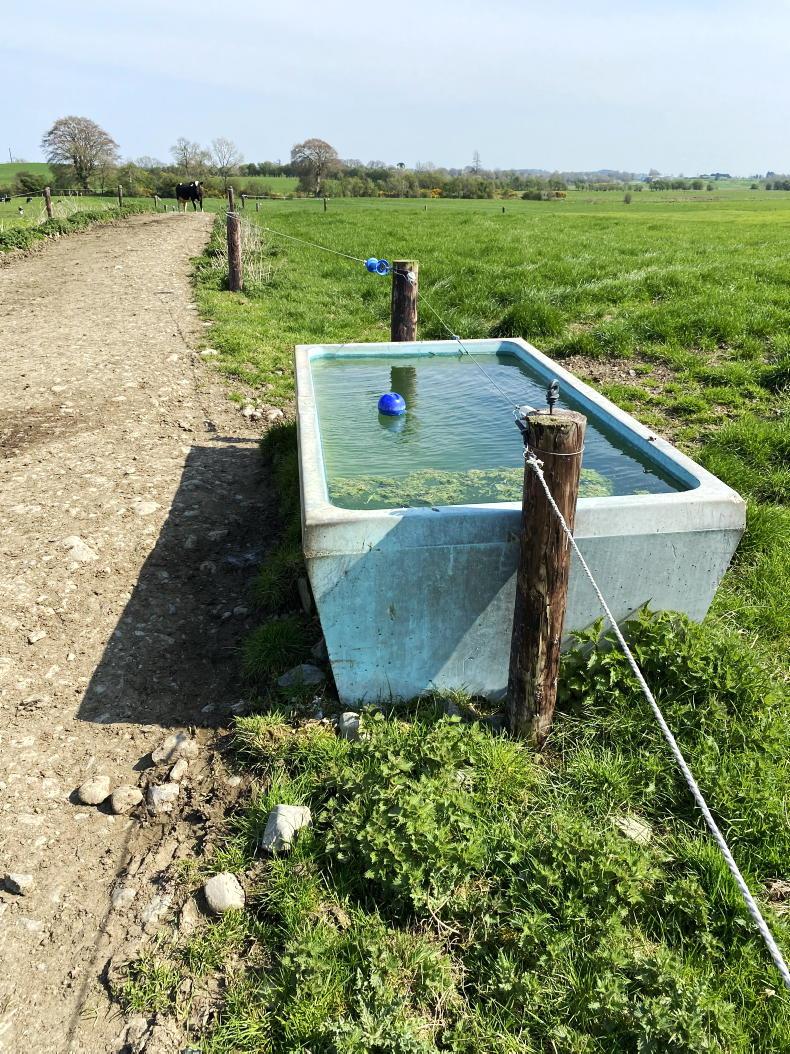Lely Centre Mullingar held an open day on Thursay last on the farm of John and Sean Gilsenan, just outside Kells, Co Meath. The full day event was organised to show an in depth look at managing a grass-based robotic dairy system, with over 50 farmers in attendance. The farm runs 260 cows with four robots in use.
Grazeways
A key focus of the day was how the robots could be incorporated in to an Irish spring-based grazing system. Two Lely grazeways were installed by the Gilsenans exiting the robots.
The first drafts cows three ways:
To a separation area for health or management to be carried out.Through the auto fill walk and a Hoofcount automatic foot bath and on to the second grazeway. Or directly on to the second grazeway. The separation area can be a designated cubicle area, dry bedded pen or, in the Gilsenans case, a designated paddock directly off the yard for the summer months within close reach of handling facilities for breeding or necessary health treatments.
The second grazeway allows for the entry and exit of cows from the three grazing blocks A, B, and C.
One-way gates lead in through the grazeway in to the queueing area for milking, with the auto pneumatic exit gate exiting the grazeway directing cows to the assigned land block. For the ABC system of grazing, the parcel of land cows are directed to changes every eight hours on a set gate time. Lely recommends change of gate times of 2am, 10am and 6pm. Where buffer feeding is required, one of the blocks can be a designated buffer feeding zone.
How the ABC system works
Originally, Lely worked off a AB system of grazing, with gate times changed every 12 hours. However, this system had flaws. Mainly cows weren’t reaching a fresh paddock after every milking. High-yielding cows that were going to the robot more often to be milked were being turned back to the same paddock post-milking, where they would remain until they presented themselves for milking again. It also often resulted in heifers, who were often the last ones to present themselves for milking, constantly being left with the last third of grazing, affecting intake of these heifers.
Lely says much better grazing plan has now been designed through the ABC system.

The Lely grazeway is key to management, sending cows to block A (left), block B (straight ahead) or block C (right).
Gate changes are every eight hours as opposed to 12. Most cows on grass-based automatic milking systems (AMS) are being milked 2-2.4 times a day. This means cows present themselves for milking every 10-12 hours, meaning they are never turned back to the same paddock.
The importance of keeping the gate changeover times fixed was highlighted by the farm management support team of Sean Callan and Jordan Molloy.
“What we are often seeing is that cows know that a changeover time is coming up, and rather than going from block A to B, which has been more than halfway grazed, they will hang on in paddock A for that extra hour or two, graze it down tight, then present themselves for milking after the gate has changed over to block C, meaning they are the first few cows in to this fresh paddock.’’
About 20% of the herd will remain in a block to graze it down to 4cm, then skip a block to be rewarded by fresh grass. Changing gate times causes cows to go out of sync with this system and is not recommended.

Farm roadways are narrow at less than 3m in width but is causing no issues on farm.
Sean also highlighted how cows will tell farmers when allocations are incorrect.
“If cows are too slow to leave paddocks you need to tighten up the allocation. If they are leaving paddocks too quickly, you’ve under allocated them,’’ he said
Virtual paddocks
The layout in Figure 1 shows the three blocks of land, A, B and C, divided roughly in to 40%,40% and 20% respectively. Sean described this as the cow’s ‘‘breakfast, dinner and tea’’. Block C is used for evening/night grazing and is a smaller allocation than blocks A or B. The smaller allocation encourages cows to leave the paddock during the night, which can prove difficult, present themselves for milking and then fill themselves in the larger A block.
The farm operates on a virtual paddock system. There is a mains fence around the perimeter and along roadways with frequent gaps to allow cows to enter paddocks. There are very few permanent fences splitting fields. The Gilsenans use reels and pigtail posts to allocate breaks, with the flexibility of this non-permanent paddock system being that they can change the size of paddocks as required depending on grass cover, stocking density etc. The Lely team explained that this works best for AMS and find that many farmers who switch to a robot end up removing many permanent paddocks in favour of this system. All this is easily achieved by cows having access to water on roadways. Troughs are located every 120-180m on the roadways.

Water troughs are accessible from the roadways and paddocks.
The Gilsenans’ roads were created using crushed stone from when the greenfield site was constructed.
At only 9 ft in width, these would ordinarily be seen as extremely narrow for a herd of this size.
Sean explained that the roads were perfectly adequate, and could accommodate significantly more cows, owing to the fact that cows went to the robot individually, or in their social groups of less than 15 cows.
He also acknowledged that the road surface was less than ideal and required topping off with quarry dust, although lameness was not an issue on farm due to cows being able to travel to the yard at their own pace and pick their path.
The benefits of cows entering and leaving paddocks individually or in small groups also pays dividends when grazing during the shoulders of the year, as it prevents large volumes of cows entering or leaving a paddock all at once.
With cows not being shut in to paddocks, the Gilsenans also see cows head towards the yard and into the cubicle shed if heavy rain falls.
Grassland management and grazing infrastructure is key to operating a profitable robotic milking system.Take home message from the Lely team was that the robotic milking system allows for greater flexibility but also frees up time to increase focus on grassland management and cow health.
Lely Centre Mullingar held an open day on Thursay last on the farm of John and Sean Gilsenan, just outside Kells, Co Meath. The full day event was organised to show an in depth look at managing a grass-based robotic dairy system, with over 50 farmers in attendance. The farm runs 260 cows with four robots in use.
Grazeways
A key focus of the day was how the robots could be incorporated in to an Irish spring-based grazing system. Two Lely grazeways were installed by the Gilsenans exiting the robots.
The first drafts cows three ways:
To a separation area for health or management to be carried out.Through the auto fill walk and a Hoofcount automatic foot bath and on to the second grazeway. Or directly on to the second grazeway. The separation area can be a designated cubicle area, dry bedded pen or, in the Gilsenans case, a designated paddock directly off the yard for the summer months within close reach of handling facilities for breeding or necessary health treatments.
The second grazeway allows for the entry and exit of cows from the three grazing blocks A, B, and C.
One-way gates lead in through the grazeway in to the queueing area for milking, with the auto pneumatic exit gate exiting the grazeway directing cows to the assigned land block. For the ABC system of grazing, the parcel of land cows are directed to changes every eight hours on a set gate time. Lely recommends change of gate times of 2am, 10am and 6pm. Where buffer feeding is required, one of the blocks can be a designated buffer feeding zone.
How the ABC system works
Originally, Lely worked off a AB system of grazing, with gate times changed every 12 hours. However, this system had flaws. Mainly cows weren’t reaching a fresh paddock after every milking. High-yielding cows that were going to the robot more often to be milked were being turned back to the same paddock post-milking, where they would remain until they presented themselves for milking again. It also often resulted in heifers, who were often the last ones to present themselves for milking, constantly being left with the last third of grazing, affecting intake of these heifers.
Lely says much better grazing plan has now been designed through the ABC system.

The Lely grazeway is key to management, sending cows to block A (left), block B (straight ahead) or block C (right).
Gate changes are every eight hours as opposed to 12. Most cows on grass-based automatic milking systems (AMS) are being milked 2-2.4 times a day. This means cows present themselves for milking every 10-12 hours, meaning they are never turned back to the same paddock.
The importance of keeping the gate changeover times fixed was highlighted by the farm management support team of Sean Callan and Jordan Molloy.
“What we are often seeing is that cows know that a changeover time is coming up, and rather than going from block A to B, which has been more than halfway grazed, they will hang on in paddock A for that extra hour or two, graze it down tight, then present themselves for milking after the gate has changed over to block C, meaning they are the first few cows in to this fresh paddock.’’
About 20% of the herd will remain in a block to graze it down to 4cm, then skip a block to be rewarded by fresh grass. Changing gate times causes cows to go out of sync with this system and is not recommended.

Farm roadways are narrow at less than 3m in width but is causing no issues on farm.
Sean also highlighted how cows will tell farmers when allocations are incorrect.
“If cows are too slow to leave paddocks you need to tighten up the allocation. If they are leaving paddocks too quickly, you’ve under allocated them,’’ he said
Virtual paddocks
The layout in Figure 1 shows the three blocks of land, A, B and C, divided roughly in to 40%,40% and 20% respectively. Sean described this as the cow’s ‘‘breakfast, dinner and tea’’. Block C is used for evening/night grazing and is a smaller allocation than blocks A or B. The smaller allocation encourages cows to leave the paddock during the night, which can prove difficult, present themselves for milking and then fill themselves in the larger A block.
The farm operates on a virtual paddock system. There is a mains fence around the perimeter and along roadways with frequent gaps to allow cows to enter paddocks. There are very few permanent fences splitting fields. The Gilsenans use reels and pigtail posts to allocate breaks, with the flexibility of this non-permanent paddock system being that they can change the size of paddocks as required depending on grass cover, stocking density etc. The Lely team explained that this works best for AMS and find that many farmers who switch to a robot end up removing many permanent paddocks in favour of this system. All this is easily achieved by cows having access to water on roadways. Troughs are located every 120-180m on the roadways.

Water troughs are accessible from the roadways and paddocks.
The Gilsenans’ roads were created using crushed stone from when the greenfield site was constructed.
At only 9 ft in width, these would ordinarily be seen as extremely narrow for a herd of this size.
Sean explained that the roads were perfectly adequate, and could accommodate significantly more cows, owing to the fact that cows went to the robot individually, or in their social groups of less than 15 cows.
He also acknowledged that the road surface was less than ideal and required topping off with quarry dust, although lameness was not an issue on farm due to cows being able to travel to the yard at their own pace and pick their path.
The benefits of cows entering and leaving paddocks individually or in small groups also pays dividends when grazing during the shoulders of the year, as it prevents large volumes of cows entering or leaving a paddock all at once.
With cows not being shut in to paddocks, the Gilsenans also see cows head towards the yard and into the cubicle shed if heavy rain falls.
Grassland management and grazing infrastructure is key to operating a profitable robotic milking system.Take home message from the Lely team was that the robotic milking system allows for greater flexibility but also frees up time to increase focus on grassland management and cow health. 








 This is a subscriber-only article
This is a subscriber-only article










SHARING OPTIONS: